
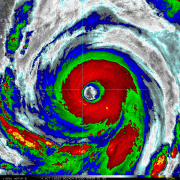
Typhoon Hagibis made landfall in Japan as a category-2 on the Izu Peninsula in the Shizuoka Prefecture on October 12, 2019, around 7 PM local time. Large stretches of the country were hit by strong winds and torrential rainfall, and the Japan Meteorological Agency issued warnings and advisories affecting all prefectures in the Honshū, Kyushu, Shikoku and Hokkaido Islands. The highest alert level was issued for 12 prefectures and affected most of the Greater Tokyo Area. Extensive flooding and landslides as a result of record rainfall were reported, along with variable wind damage. Evacuation orders and advisories were issued across 17 prefectures affecting millions. Flights, trains and ferries were suspended, and power outages affected almost half a million households. At least 56 fatalities have been reported along with over 200 injured and 15 missing, according to media reports. Relief efforts are ongoing and it will take time to assess the full scope and severity of the event. Our first thoughts and concerns are with those directly affected by this event.
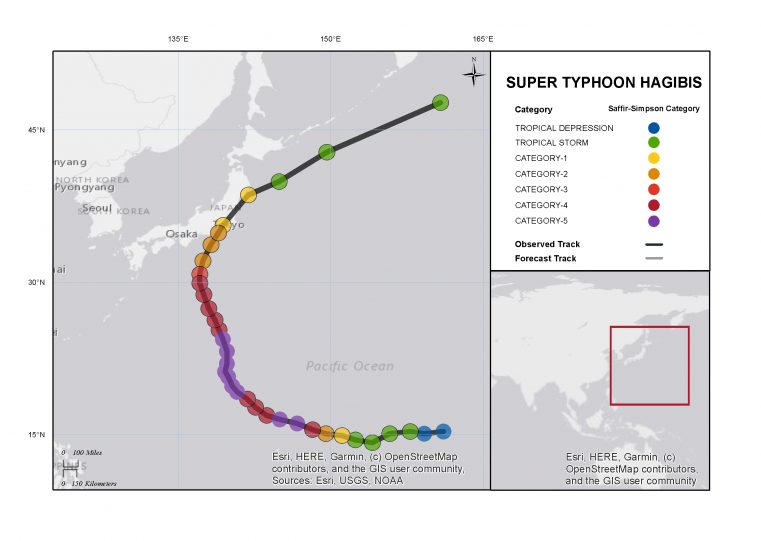
Position and intensity reports. Source: JTWC.
Physical Discussion
Super Typhoon Hagibis originated from a tropical disturbance north of the Marshall Islands around October 2. The feature later evolved into a tropical depression east of Guam, and the Joint Typhoon Warning Center (JTWC) and Japan Meteorological Agency (JMA) both began issuing advisories on October 5. While tracking westward the feature rapidly intensified into a tropical storm, with the JMA issuing the name Hagibis, as the 19th named storm of the season in the Northwest Pacific Basin. Due to warm sea surface temperatures and low wind shear the storm gradually strengthened while moving on a west-northwest course approaching Guam, and was upgraded by the JTWC to a category-1 typhoon on the Saffir-Simpson Scale at 18 UTC October 6.
In the 18 hours that followed, Hagibis underwent a period of rapid intensification to reach peak strength as a category-5 super typhoon, with 1-minute sustained wind speeds of around 260 km/h (160 mph), making Hagibis the strongest tropical cyclone in the Northwest Pacific this year so far. As the system made its closest approach to the northeast of Guam after 12 UTC October 7, the local National Weather Service estimated typhoon-force winds extending about 105 km (65 miles) from the eye.
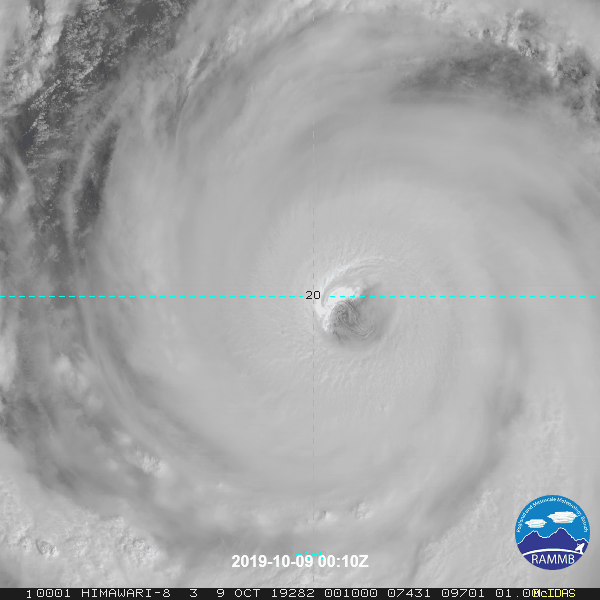
Satellite loop (visible) showing Hagibis at peak intensity. Ending October 9 0150 UTC. Source: NOAA/NESDIS.
After clearing Guam the typhoon continued towards Japan on a gradual turn to the north-northwest and then north-northeast, around the western edge of a break in the subtropical ridge. In the meantime, Hagibis began to gradually weaken after 06 UTC October 10 due to cooler waters and increasing wind shear, before making final approach to Honshu.
Just prior to landfall at 06 UTC October 12, the JTWC reported 1-minute sustained winds of around 160 km/hr (100 mph), a category-2 on the Saffir-Simpson Scale. According to the JMA and media reports, Hagibis then made landfall on the Izu Peninsula (Shizuoka Prefecture) southwest of Tokyo on October 12 around 7 PM local time (10 UTC). Around the time of landfall at 09 UTC October 12 the JMA reported 10-minute sustained winds of around (145 km/hr) 90 mph, while the JTWC reported 1-minute sustained winds of around 160 km/hr (100 mph), both roughly equivalent to a category-2. While moving over land on a north-northeast track the center of circulation then passed very near the Greater Tokyo Area. In the meantime Hagibis had weakened to a category-1 due to land and topography interaction and increasing wind shear. At 10 PM local time the typhoon was tracking over the Saitama Prefecture north of Tokyo.
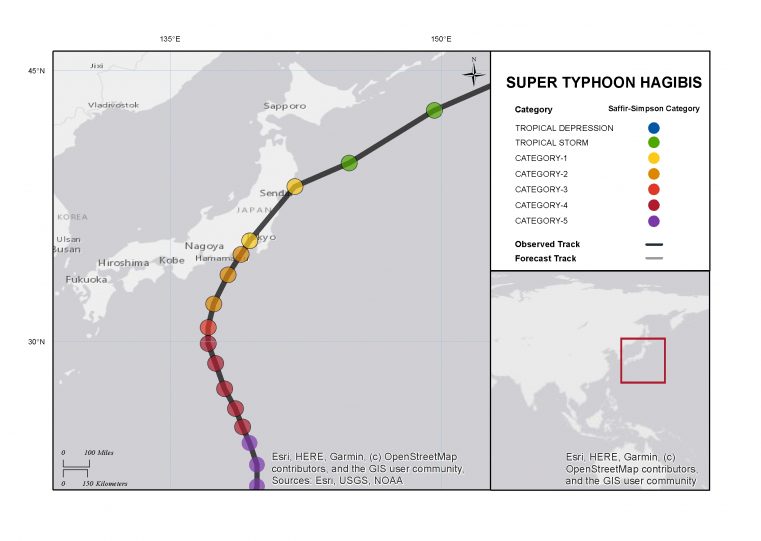
Position and intensity reports. Source: JTWC.
Hagibis brought strong winds and record-breaking rainfall along with at least one tornado reported near Ichihara. Cumulative precipitation in Hakone (Kanagawa Prefecture) reached 939 mm (37 inches), equivalent to about three times the usual amount of rainfall during the month of October. Another record was set in the district of Yugashima (Shizuoka Prefecture) with 717 mm (28 inches), while the city of Shima (Mie Prefecture) was hit by 409 mm of rainfall (16 inches). Heavy rains caused severe flooding and landslides in various prefectures. After clearing the Fukushima Prefecture the typhoon re-entered the Pacific Ocean, transitioning first into a tropical storm and hours later into an extratropical cyclone, before approaching the Kuril Islands.
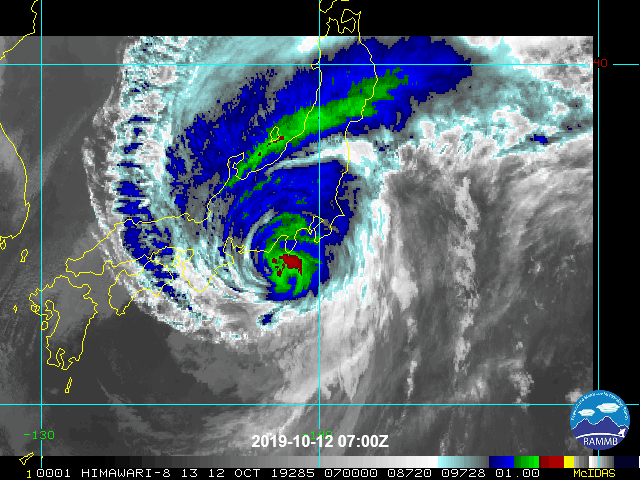
Satellite loop (infrared) showing Hagibis near the time of landfall. Source: NOAA/NESDIS.
Impacts
Hagibis has left at least 55 dead and over 200 injured with another 15 still missing, according to media reports. Evacuation advisories were issued for up to 9 million people across various prefectures, with over 800,000 households ordered to move to government shelters. The highest possible level of warning was issued to the prefectures of Gunma, Saitama, Kanagawa, Yamanashi, Nagano, Shizuoka, Niigata, Fukushima, Tochigi, Ibaraki, Miyagi and Iwate. Over 110,000 police officers, firefighters, coast guard officials and members of the Japan Self-Defense Force were dispatched in the affected areas to support rescue work.
Significant damage has been caused by extreme precipitation and resulting flooding, along with variable wind damage. Flood damage includes effects from water velocity and waterborne debris as well as inundation, as evident from initial media reports. According to the Land and Transport Ministry, several levees have collapsed along 21 waterways in the Nagano, Niigata, Miyagi, Fukushima, Ibaraki, Kanagawa and Saitama prefectures. As rivers overflowed their embankments, flooding was reported in various cities including Tagajou (Miyagi Prefecture) and in areas of Tokyo impacted by the Tama River. The Tokyo suburb of Hachioji was also inundated due to overwhelmed drainage systems. Severe flooding was also reported in the city of Nagano, where according to Japan's Geospatial Information Authority, flood waters from the Chikuma River reached a maximum depth of over 4 meters. Extensive damage was also reported in the Shimo-Osaka district in the city of Kawagoe (Saitama Prefecture) due to overflowing of the Oppe River. Meanwhile in the Fukushima Prefecture, the Abukuma River burst its banks, causing flood waters to reach the second level of affected buildings. As an emergency flood prevention measure, authorities began discharging water from six dams: the Mizunuma and Ryujin dams (Ibaraki Prefecture), the Miwa Dam (Nagano Prefecture), the Shiroyama Dam (Kanagawa Prefecture), the Takashiba Dam (Fukushima Prefecture) and the Shiobara Dam (Tochigi Prefecture). Media reports indicate at least 3,400 homes flooded across the country. Meanwhile a tornado affected portions of Ichihara to destroy at least 12 houses and render damage to at least 70 others.
Over 50 landslides and mudslides have also been reported so far across 15 prefectures. Several homes have been destroyed as a result in Gunma prefecture, according to initial reports. A magnitude 5.7 earthquake occurred off the coast of Chiba Prefecture shortly after the typhoon made landfall, loosening the soil and increasing the risk of more landslides.
Extensive blackouts have affected nearly half a million households in eastern and central Japan, especially in Tokyo and in the Shizuoka, Chiba, Nagano and Kanagawa prefectures. The Tokyo Electric Power Company and the Ministry of Economy, Trade and Industry distributed mobile generators to various hospital and evacuation centers. Additionally, over 120,000 households were left without running water.
Hagibis paralyzed public transport in the Greater Tokyo Area. East Japan Railway Company and Japan Railways Group suspended services on many lines, including the Yamanote, Chuo and Tokaido. East Japan Railway Company announced ten Hokuriku Shinkansen bullet trains worth ¥ 32.8 billion (US$ 303.2 million) were damaged as its maintenance depot in the Nagano Prefecture was flooded. A railway bridge over the Chikuma River in Ueda (Nagano Prefecture) also collapsed. Over 1,600 flights were canceled including all those to and from Haneda and Narita, the two international airports serving the capital. Among other carriers, Japan Airlines and All Nippon Airways cancelled over 500 flights each. Meanwhile according to the Japan Coast Guard, the typhoon sank Jia De, a 1,925-ton Panamanian cargo ship anchored in the Tokyo Bay off the coast of Kawasaki. Seven crew members died and one is currently missing, according to media reports.
The typhoon also impacted telecommunication infrastructure, with mobile and landline phones experiencing connection problems in the Kantō and Tohoku regions. Power outages and the breakdown of communication lines affected the NTT Docomo, au by KDDI and Softbank cellular networks in various prefectures including Shizuoka, Miyagi, Iwate, Kanagawa and Chiba.
The widespread power outages and flooding affected many companies. Among the retailers affected, FamilyMart Co. temporarily closed about 50 convenience stores, and Isetan Mitsukoshi Holdings Ltd. shut down various department stores. Many other commercial activities were disrupted, including the Tokyo Disneyland and the Tokyo DisneySea theme parks. Honda Motor Co. suspended operations at four plants, and Toyota Motor Corp., Nippon Steel Corp. and Sapporo Holdings Ltd. shut down various factories. Although various oil refineries suspended production, major refiners including JXTG Nippon Oil & Energy, Fuji Oil and Cosmo Oil did not report any substantial damage to their infrastructure.
The Tokyo Electric Power Company reported irregular readings from sensors monitoring radiation levels in water at the Fukushima Daiichi Nuclear Power Plant, which was damaged by the Tōhoku earthquake and tsunami in 2011. Officials confirmed that torrential rainfall caused 11 leak alerts at the plant, but did not clarify whether any radioactive material contaminated the ocean or other water bodies. An unspecified number of bags containing decontaminated waste from the nuclear power plant were transported by flood waters into the Furumichi River. Officials declared that there is no immediate danger to the public, and that six 1-ton bags have been recovered so far.
Various events were also suspended. Three games of the Rugby World Cup were cancelled, together with all practice and qualifying sessions of the Formula One Grand Prix.
Sources: Japan Meteorological Agency, Joint Typhoon Warning Center, NOAA, Weather Underground, The Weather Company, The Japan Times, The Mainichi, Kyodo News, NHK World Japan, Nikkei Asian Review, Bloomberg, Reuters.